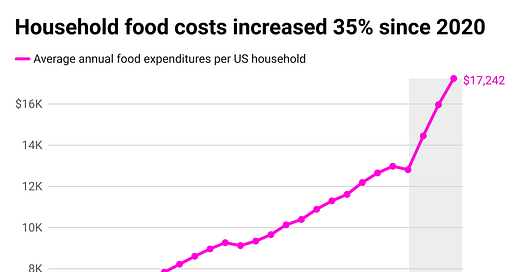Food prices are as high as you think they are, Biden avoids the issue at the debate
Polygraph | Newsletter n°256 | 1 July 2024
Situation
Cost-of-living related issues dominate voter concerns. Polling from YouGov reports “inflation and high prices” as the most important issue for both Democrat and Republican voters; Gallup lists “inflation” as the issue most Americans worry a lot about; Data For Progress says “economy, jobs, and inflation” is the foremost area of consideration for all voters and undecided voters when they fill out their ballots. It’s unsurprising, then, that voters respond much more positively to class-based appeals and populist economic messages than they do ones centered on abstract ideas like democracy.
“Preserving America’s democracy is the central cause of my Presidency,” Biden said at a campaign rally in January. In March, Biden’s chief strategist Mike Donilon told the New Yorker that their campaign is primarily about “democracy” and “the soul of the nation.” By the time the election rolls around, “The focus will become overwhelming on democracy,” Donilon said. “I think the biggest images in people’s minds are going to be of January 6th.”
This all sounds like a deeply flawed theory of victory. Besides, January 6 isn’t even the main thing most people associate with Trump. Per a New York Times poll from May: “When asked to describe the one thing they remembered most from Donald J. Trump’s presidency, only 5 percent of respondents referred to January 6.”
The debate
The Biden campaign’s lack of emphasis on appealing to people’s material interests was evident on Thursday. In the first question of the debate, Jake Tapper referenced stubbornly high food prices before asking Biden, “What do you say to voters who feel they are worse off under your presidency than they were under President Trump?”
Despite Tapper’s helpful nudge, Biden offered voters no plan to bring grocery prices down or help them deal with the new normal — he could’ve at least promised a $15/hour minimum wage, for example.
After the debate, CNN’s Erin Burnett said Biden “goes through six days of preparation at Camp David” and “knows every one of these questions is coming.”
Blame Biden’s alleged cold or other medical condition if you want, but he might’ve sidestepped the food cost issue because he doesn’t have a plan for it. It’s unclear whether his campaign has given the matter much more thought than Trump has. They’ve reminded us plenty that democracy is on the ballot, though.
Food costs
Every time I even go near a grocery store it kicks me in the head and steals my wallet. Worse still, many others must feel the same way.
I plotted out average annual food expenditures per US household from 1997 to 2023 using data from the United States Department of Agriculture (USDA). As the chart below shows, nominal food costs go up pretty much every year — but not like they have since 2020.
The three largest annual increases in average household food costs on record occurred in the last three years. As a share of overall household expenses, the only years where average annual food costs ate more than 11 percent were 2022 and 2023.
^Alt text for screen readers: Household food costs increased 35% since 2020. This pink line chart shows average annual food expenditures per US household over time from 1997 to 2023. It steadily increases pretty much every year until it shoots dramatically upwards after 2020. Data: United States Department of Agriculture (USDA).
SPECIAL THANKS TO: Alan F., Andrew R., Bart B., BeepBoop, Bill S., Byron D., Chris G., David S.,* David V.,* Francis M., Irene B., Gary W., George C., Jcowens004, Jerry S., John A., Joseph B., Kheng L., Linda B., Lora L., Marie R., Mark G., Matthew H.,* Megan., Meghan W., Nick B., Omar D.,* Peter M., Philip L., Rosemary K., Silversurfer7, Springseep, Theresa A., Themadking724, Tim C., Tony L., Tony T.
* = founding member




